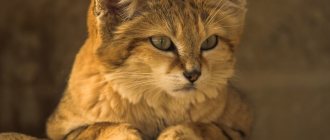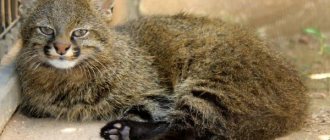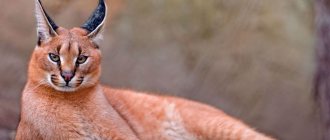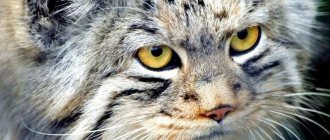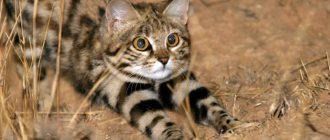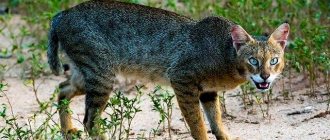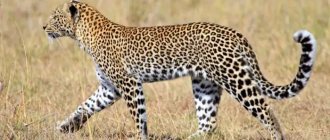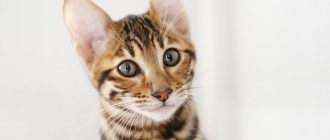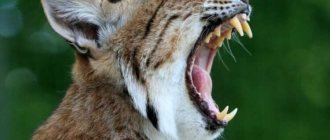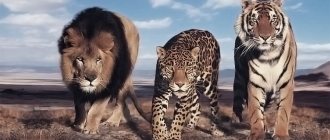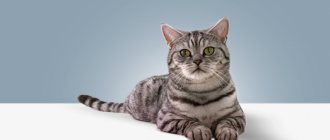Little wild cat
"Tiger cat" redirects here. For other uses, see Tiger cat (disambiguation).
Tiger cat may also be the common name for the tiger quoll.
| Oncilla | |
| Save Status | |
| Vulnerable (IUCN 3.1) [1] | |
| Scientific classification | |
| Kingdom: | Animalia |
| Type: | Chordata |
| Class: | Mammals |
| Order: | Predator |
| Suborder: | Feliformation |
| Family: | Feline |
| Subfamily: | Felines |
| Genus: | Leopard |
| Variety: | L. tigrinus |
| Binomial name | |
| Leopard tigrinus (Schreber, 1775) [2] | |
| Oncilla Distribution, 2021 [1] | |
| Synonyms | |
| Oncifelis tigrinus , | |
Oncilla
(
Leopardus tigrinus
), also known as
the northern tiger cat
,
a small spotted cat
, and
tigrillo
, a small spotted cat, ranging from Central America to central Brazil. It is listed as vulnerable on the IUCN Red List, and the population is threatened by deforestation and habitat conversion to agricultural land. [1]
In 2013, it was proposed that oncilla populations in southern Brazil, Paraguay and Argentina should be classified as a new species: the southern tiger cat L. guttulus
, after it was discovered that it did not interbreed with the oncilla population in northeastern Brazil. [3]
Captivity
The oncilla is a wild animal, so acquiring one as a pet will bring some difficulties. It is not recommended to keep such a cat in an apartment, and when caring for it you need to remember the following nuances:
In order for an animal to be happy and healthy, it needs to be provided with a spacious enclosure with plenty of open space. It should contain tall trees or artificial objects imitating them, which the animal can use for exercise and relaxation.
It is also important to take care of creating a temperature regime in which the oncilla will feel comfortable. Since these animals are excellent climbers, it is important to take care that they do not escape. All windows in the room where they are kept must be equipped with strong bars
Closed enclosures are preferred. Other small animals, including domestic cats and dogs, should not be allowed into the place where the predator is kept. He can easily perceive them as prey, a threat, or trespassers. Children should also not be allowed near this animal, even if it does not pose a danger to an adult. Oncillas are very independent, obstinate and nocturnal, sometimes making a lot of noise. This should also be taken into account when purchasing such an exotic pet. You need to feed a wild cat with fresh meat - usually beef is used for this. To support health, vitamin and mineral supplements containing various microelements and other necessary substances must be introduced into the diet. When feeding these predators, live food in the form of small rodents or birds is widely used - hunting them allows the animal to maintain itself in good shape. In addition, they need to periodically go on fasting days, following a schedule. The health, diseases and genetic characteristics of this species are very poorly understood. Therefore, it is advisable that a captive predator be under constant veterinary supervision.
The cost of each individual depends on factors such as gender, age, intensity and beauty of color, as well as the quality of the pedigree. The price starts from 2 thousand US dollars, which is about 135 thousand rubles. It is best to buy these exotic animals in nurseries. There, wild cats are raised using special technologies. Kittens undergo strict selection, adapt to humans, and receive the necessary care and vaccinations. A passport and other documents are issued for each animal. Reception staff usually also provide consultations and other services related to the animal’s adaptation to a new habitat.
Security status
Oncilla is known as the small spotted cat, tiger cat, ocelot, or tigrillo, but these names are also used to describe the margay and ocelot cats because their geographic range overlaps significantly.
Oncilli can be mistaken for long-tailed cats (margays) or juvenile ocelots, meaning their presence is difficult to detect in any area. Researchers in Brazil found that few former hunters and the most experienced indigenous people could tell the three species apart.
In southern Brazil, their range overlaps with Geoffroy's cats, and there is some evidence of hybridization between the two species.
Oncillas have been hunted for their fur throughout their range. A report on South American cats found that between 1976 and 1982, oncillas were one of the four most traded small cat species. It is difficult to assess threats to this species when so little is known about it. Scientists suggest the possibility of oncilla existence in deforested coffee and eucalyptus plantations on the outskirts of São Paulo.
Oncillas are classified as "vulnerable" on the IUCN Red List of Threatened Species. Although these cats are protected under Appendix I of CITES (Convention on International Trade in Endangered Species of Wild Fauna and Flora), they are rarely found in protected habitats. The phylogenetics of this species are not well established, and it has been suggested that populations that occur in the northernmost part of their range may represent a distinct species.
At the end of the 20th century, oncillas were a very popular hunting object among poachers. This species gained such popularity due to the beauty of its fur. At the moment, the population of these cats numbers up to 50 thousand individuals. The main threat to the species remains poachers, as well as coffee production, for the cultivation of which forests are cut down in the oncilla's habitats. Hunting these cats is prohibited by law in most countries that cover their habitat.
If you find an error, please highlight a piece of text and press Ctrl Enter.
Description, lifestyle and habitat in the wild
In appearance, the Andean cat is almost identical to the Pampas cat, which lives next to the species in question. Scientists have still not established their main differences, and research on this matter has been ongoing for many years.
Did you know? Andean cats were first described in 1865, but evidence of their existence before 1998 was only two photographs taken by researchers during an expedition in the 1980s. New observations, which made it possible to better understand Andean predators, were made by researchers at the end of 1998.
The predator lives in northern Chile, southern Bolivia, and northwestern Argentina. The entire habitat is more than 600 square meters. km. The animal's favorite habitat is a rocky valley surrounded by ridges and slopes. The cat has adapted well to the conditions of a dry, cold climate. In order to catch food, the predator is able to travel long distances and conquer impressive heights, up to 5 km.
Despite the fact that the predator looks very much like lazy domestic carefree cats, it is not at all similar to them in its lifestyle and behavior in nature. He is dexterous and maneuverable, has more developed hearing, which allows him to hear the slightest rustle at a great distance and hide from danger. Animals tend to be solitary and do not tend to live in packs.
Sometimes they betray their principles; this period falls during the mating period, which can be replaced by caring for the offspring, but when they grow up and are able to hunt on their own, the animals again go into solitary existence. One individual occupies a property of 40 square meters. km, which is marked with excrement and protected from other predators.
Important! Predators make their lair in the most remote and hard-to-reach places, which include rocky areas, rock crevices, and thickets of low-growing bushes. Thanks to these conditions, animals are protected from other predators.
Hunting and diet
Like all cats, oncilla is a predator. Despite their small size, these animals are very dexterous and skilled hunters, who often kill prey larger than themselves. They prefer to hunt at night. Having spotted a victim, a wild cat can wait in ambush for hours, looking for the right moment to attack. When an unsuspecting animal comes close enough, the oncilla quickly rushes at it, catching up in a few seconds.
Unlike domestic cats, these predators do not have the habit of playing with their prey and kill it with one precise blow to the neck or head. In this they are helped by sharp, strong claws and unusually strong fangs. The diet of oncillas includes:
- small rodents that share their habitat with these wild cats;
- birds from which the predator carefully plucks the feathers before eating;
- eggs left in nests;
- small non-venomous snakes and tree frogs (according to unconfirmed reports);
- fish - if the animal lives near a body of water.
According to some eyewitnesses, in Brazil, oncillas sometimes prey on small monkeys. Their excellent tree-climbing skills allow exotic cats to catch up and kill agile primates, providing themselves with a hearty meal. In hunting, predators are helped not only by their speed and grace, but also by very acute hearing, as well as an excellent sense of smell, which allows them to track prey in the twilight of night forests.
Caring for Oncilla
In the created enclosure, the animal will not require special care. The wild cat carries out water procedures itself. If you trust, you can comb your pet's fur a couple of times a month, but this is also not particularly necessary. Oncilla feeds mainly on raw, lean fillets: rabbit and various birds. The enclosure must be kept impeccably clean so that the cat feels comfortable.
Maintenance necessarily involves regular examination by veterinarians and necessary vaccinations. Oncilla is a predator by nature, which can show aggression towards others and actively defend itself. Unfortunately, the population is decreasing and very soon they may remain only in private enclosures.
Oncilla protection
Photo: Oncilla from the Red Book
Oncilla is listed in the Red Book under the status of a vulnerable species. The population has almost been restored, and oncillas are widespread, although very rare. Poaching was a real scourge for the population of these cats, since several tens of thousands of oncillas were destroyed between 1970 and 1980. And in 1983, about 84 thousand skins were confiscated from poachers.
At the moment, there are about 50 thousand adult oncils. The figure is unstable and sometimes increases and sometimes decreases due to deforestation. Hunting for oncillus is prohibited, but in many regions where it lives, it is not awarded the status of a protected animal.
Namely, it is not guarded in the following places:
- Ecuador;
- Guyana;
- Panama;
- Nicaragua;
- Peru.
The International Convention on Trade in Wild Animals and Plants listed oncilla as an appendix back in 1989. No specific work is being done to support or restore the population due to the difficult living conditions of this cat. It is reliably known that the hunt for her has completely stopped.
The oncilla is a beautiful and deadly animal. Despite its cute appearance, this cat is not adapted to life at home due to its natural aggressiveness and increased activity at night. It remains to be hoped that the oncilla population in the wild will be fully restored.
Tags:
- Deuterostomes
- Bilaterally symmetrical
- Wild cats
- Animals of Argentina
- Animals of Brazil
- Animals of Venezuela
- Animals of Guyana
- Animals of Colombia
- Animals of Costa Rica
- Animals of the Red Book
- Animals of the forest
- Animals starting with the letter O
- Animals of Nicaragua
- Animals of Panama
- Animals of Paraguay
- Savannah animals
- Animals of the Subtropical Zone of the Southern Hemisphere
- Animals of the Subequatorial Belt of the Southern Hemisphere
- Rainforest Animals
- Animals of the Tropical Zone of the Southern Hemisphere
- Animals of Uruguay
- Animals of Ecuador
- Animals of South America
- Animals
- Felines
- Cats
- Felidae
- Laurasiotherium
- Small cats
- Placental
- Vertebrates
- Rare animals
- Rare animals of the world
- The most beautiful animals
- Unique animals
- Predatory
- Predatory animals
- Predatory cats
- Chordates
- Ghostostomes
- Quadrupeds
- Eukaryotes
- Eumetazoans
- South American cats
Number of species Sumatran wild cat
The main enemy of any rare animal is man. Man is capable of exterminating any species, even large animals, let alone small Sumatrans. But even if Malaysians stop catching and killing these cats, human activity will still cause irreparable damage to the environment. All this leads to the fact that it becomes more difficult for wild animals to survive.
Cat population numbers are affected by fishing
The Sumatran wild cat is listed in the International Red Book as a vulnerable and endangered species. Trade, acquisition, captivity and killing of such an animal promises administrative and criminal punishment.
The Sumatran wild cat is a species of small omnivorous cat native to Indonesia. Such animals feed on fish, frogs, other inhabitants of fresh water bodies and some plants. When hungry, the flat-headed cat may attack birds and chickens kept on nearby farms. To fight cats, local residents set traps with poison. In addition, people cut down mangrove forests and pollute water bodies. Because of this, the number of wild cats is constantly declining. Currently, the Sumatran cat is listed in the International Red Book.
Appearance description
The name "oncilla" translates as "little jaguar". Externally, this cat really looks like a miniature jaguar, not only in color, but also in physique, as well as the general structure of the body.
The animal's fur is soft, but rather short, and the main color is grayish-red. The belly and chest are lighter than the back and sides. Black longitudinal spots stretch along the spine, the tip of the tail is covered with transverse stripes. Dark rings of different shapes and sizes are randomly located throughout the body, not breaking up into specks. Among these predators, individuals with melanism and black coloration are often found - their number reaches 20% of the population.
The size of the wild oncilla is quite small - it is slightly larger than a domestic cat, but is inferior in size to the ocelot and its other relatives that do not live in tropical zones. The weight of a large male is about 2.8−3 kg with a body length of 65 cm. Females are smaller - their body weight rarely exceeds 1.5−2.5 kg. The predator's physique is quite powerful, but this does not prevent him from being dexterous and graceful. The tail is of medium length (up to 35-40 cm) and thickness, mobile. The front legs are slightly shorter than the hind legs. The claws are retractable, strong and sharp.
The ears are rounded, erect and very large, there are no tufts on them. Their light inner part is covered with light fluff, and the outer part is covered with black fur. There is a small white spot approximately in the middle of each ear. There are also characteristic light markings on the animal’s face in the area of the eyelids, cheeks and chin. The eyes of oncillas are large and expressive, very prominent against the background of the entire appearance of the cat. Their color varies from amber yellow and light brown to chocolate. The pupils are narrow and vertical.
Best articles: Structure, role and formation of peroxisomes
Description of Oncilla
- Appearance.
The appearance of this cat is closest to the appearance and coloring of the South American jaguar. But the dimensions... The body length is only some 80–96 centimeters, and the body weight of the largest individuals reaches only 2.5 kg, which is 44 times less than the weight of the average jaguar. However, this miniature jaguar is very beautiful. Wonderful flexible and athletic elongated body, with strong bones and strong paws. A small head with a cute muzzle on a muscular neck of medium length. Huge honey-yellow eyes, large ears, rounded at the ends. Dense, as if “stuffed”, short and very soft fur of a magnificent yellow-ocher color with clear spots of a “jaguar” pattern. - Distribution area and habitat.
Oncilla is distributed throughout Central and South America. It is especially common in Brazil, Argentina, Venezuela, Paraguay and Ecuador. The northernmost recorded habitat is Costa Rica. For their existence, miniature jaguars give the greatest preference not to the high-mountain moist evergreen forests of South America, but they are often found in drier areas, as well as in areas of deforested eucalyptus forests or in abandoned plantings. Sometimes this miniguar cat can be found directly near human habitation. - Onicilla lifestyle.
This feline is a solitary nocturnal predator whose main prey includes all species of small rodents of South America, birds, tree frogs, reptiles (non-venomous) and even some small primates and their young. And while oncillas spend most of the night hunting, during the day these predators prefer to rest on the branches of tall trees, safe from larger predators. Despite the fact that the size of the oncilla is small, their character is quite aggressive and bloodthirsty. Defending their territory or life, they are able to seriously stand up for themselves, fearlessly attacking a trespasser or an attacking predator. - Enemies.
Despite the fact that the size of the oncilla is very small, it has practically no natural enemies capable of catching this dexterous and nimble cat. Her main enemies are poachers who hunt for her beautiful fur. But these days, more and more harm to the population of these cute animals is caused not even by illegal hunters (oncilla is taken under protection by almost all states), but by logging companies that are constantly destroying their main habitat - the evergreen forests of South America. - Keeping in captivity.
Oncillas can be tamed quite well, but their living conditions must meet all the requirements for keeping wild animals. The oncilla should never be treated as a harmless house cat. She always remains a wild and dangerous predator, with aggressive instincts. This should not be forgotten.
The recorded lifespan of oncillas in captivity is about 20 years. In nature (as zoologists suggest) - up to 12–15 years.
General information
Origin
In 2021, based on research results, three groups of oncilla cats were approved, one of which was recognized as an independent species - the tiger cat. Although, it is difficult for the average person to accept this division, because the classification is based on the texture and variety of patterns on the skins.
Appearance
Although the oncilla is called a tiger cat, it looks like a very small jaguar or its cub. In relation to the size of an ordinary domestic cat, this species of wild cat is slightly larger, but most often about the same.
Females are almost half the size of males, so if we talk about size, you should always consider the lower threshold to be the size of a female, and the upper threshold to be the size of a male. So the body of an adult oncilla is 38-65 centimeters, plus a tail that is 2/3 the length of the body. The weight of a male usually does not exceed 3 kilograms, and that of a female 2.
In terms of the structure of the skeleton and muscles, the cat is built, like all wild species, very harmoniously, has a small flattened head and an elongated muzzle. The ears are without tassels, with sparse white hairs inside and thick black fur on the back wall. The eyes are slightly bulging, the iris is yellow-brown. The nose is charmingly pink, with a black edging. It is distinguished by the extremely close location of the mustache to the nose.
The paws are thin, long, and the pads can hide and extend their claws to their entire length.
IMPORTANT: the population of mini-jaguars is protected by the Red Book as a vulnerable species. This is due to the reduction of natural habitat by humans
The entire color palette of this wild cat is aimed at camouflage in dark foliage and the play of sunlight among the leaves.
INTERESTING: Among wild oncilla cats, approximately 15% of the population are always black. This phenomenon is caused by melanism and is common in many wild tabbys.
Habits and life in the wild
Small, but remote, and also extremely cunning and a real special forces specialist in matters of camouflage - all this is about the tiny oncilla, which, thanks to all these qualities, was able to hide from humans for so long. But the adult oncilla is in no hurry to make contact with its relatives. Active contacts occur only during the rutting period.
The tiger cat does all its business at night; wakefulness during the day is extremely rare and is always caused by a serious irritant in the territory. Oncilla spends 90% of its time on tree branches, where its camouflage ability makes it invisible to most predators and humans in particular.
The habitat of an adult female is approximately 2.5 kilometers, but the male appropriates up to 17 square kilometers. The ranges of males and females may touch, but not overlap. The male and female spend a lot of time just before mating. The period of courtship and being together with cats of this species is very gentle and touching. Typically this period lasts 3-9 days, after which the partners disperse back to their territories.
When hunting, the oncilla doesn’t care where its prey is. This striped cat climbs trees and branches better than any monkey, it also swims and runs excellently, and its assertive and ferocious disposition will not give its prey any chance of escaping. But this does not mean that the oncilla rushes through the jungle for everything that is tasty. She can sit in ambush for enough time to attack at a moment when the victim does not see her at all and does not hear her jump.
Wild oncilla never stores prey on branches, as leopards do, for example. She catches what she can eat at a time and hunts every night for this reason. The most delicious for a tiger cat: mice and rats, gophers, birds, frogs, fish, lizards, macaques and snakes. An interesting fact is that the oncilla not only eats the bird’s carcass, it cleans it of feathers, and can also then feast on the contents of the nest.
When there is a “failure” of small animals in the jungle, the oncilla does not mind snacking on large beetles and larvae.
General characteristics, habitat zones
Where does he live? Ocelots are medium-sized wild cats that live in the southwestern United States, Mexico, South America, and Central America. Predators are listed in the Red Book, but do not belong to endangered species, since the number of these animals is about 40 thousand individuals and does not show a tendency to decrease on a global scale.
In past centuries, these cats were considered a valuable hunting trophy due to their beautiful fur, mottled with black markings of varying widths.
Most likely, the name of the animal comes from the Indian dialect. There is a version that the name is etymologically related to the word “cellatus”, which in Latin means “with eyes” and contains a hint of the spotted color of the cat’s skin. Residents of various areas give wild tabby cats their own folk names, indicating their resemblance to tigers or jaguars (tigrecillo, tigrillo, jaguatrica, gato tigre).
Genetic studies indicate that Ocelots have existed as a distinct species for over a million years. Close relatives are the following representatives of the cat family:
- Oncilla;
- Andean;
- Geoffroy;
- Margay;
- Guinha;
- Pampasskaya.
What does it look like? Representatives of the species are characterized by an athletic build with elongated legs. The size of the body together with the head ranges from 60 cm to a meter, the tail is not too long - up to 0.4 m. The weight of an adult female is 6.5-11.5 kg, a male is 7-15.5 kg.
The fur color of the animals is an impressive interweaving of coal-black geometric lines of varying thickness and size. Several long stripes are located along the spine along the entire length of the back, right down to the end of the tail. The background of the fur is painted in grayish-brown or beige-red colors of varying degrees of saturation. The lower part of the body is light. The length of the hairline is up to a centimeter.
The shape of the ears is round. The tip of the large nose is pink or brick colored. Eye color – brown.
Although Ocelot is similar to Margay, it differs in twice the mass and has a shortened tail. The size of the animal is closer to that of a lynx. The largest cats can be confused with young jaguars, but the striped color gives the predator away.
Predators live in various climatic zones: savannas, tropical jungles, mangrove swamps. Habitats rise to a height of up to 3 km above sea level. Animals prefer to settle in areas with dense vegetation; during daylight hours they try to stay away from open areas. In the United States, these representatives of the cat family live in National Parks or private property. There are cases of registration of individual individuals outside protected areas, but generally the animals try to stay away from people. In Mexico, predators live in pine thickets at an altitude of 2 km above sea level.
Origin of the species and description
Photo: Oncilla
Oncilla is an unusual member of the cat family. This medium-sized cat is a deft hunter in its habitat. Although wild cats tend to be large, the oncilla is a small animal, but its size gives it an advantage over its competitors in the food chain. There are several subspecies of oncilla, which differ mainly in their habitat.
As a rule, there are three of them, although the latter is often divided into two more subspecies:
- Leopardus tigrinus tigrinus;
- Leopardus tigrinus guttulus;
- Leopardus tigrinus pardinoides.
These species also differ in color and pattern texture, although the differences are minor, so the classification of oncills is often questioned. Wild cats descended from miacidae - creatures that looked similar to large martens, which lived back in the Paleocene. During the Oligocene, these animals became harsh carnivorous predators, occupying the top of the food chain.
Video: Oncilla
It was then that the main subfamilies of cats began to separate:
- big cats such as tiger, lion, cheetah, leopard;
- small cats - manul, forest cat, oncilla and domestic species;
- saber-toothed cats that became extinct at the end of the Pleistocene.
The classification of Oncilla as a small cat is conditional, since it is still larger than other representatives of small cats, but at the same time significantly smaller than the subfamily of big cats. The closest relative of the oncilla at the present time is the leopard (or panther). The similarity is conditional, since the oncilla is only similar to a leopard in color, and therefore in its lifestyle, which is due to constant camouflage.
The range of the ocelot and its role in the ecosystem
Ocelot populations occupy some areas of South America (Bolivia, Argentina, Peru, Brazil, etc.) and the USA. Previously, there were more ocelots, they inhabited Louisiana, Arkansas and Arizona. Currently, only scattered groups of ocelots remain in Texas. True, sometimes single individuals move from Mexico to Arizona.
Typically, spotted cats live at an altitude of no more than 1,200 meters above sea level, but some groups have been found on the high slopes of the Andes (up to 3,800 meters).
Video: ocelot fishing
https://youtube.com/watch?v=q2L5JPY-jdc
The ocelot, like any other predator, occupies not the last place in the food chain. Most ocelots feed on terrestrial species. These predators exterminate rodents, which are considered pests of agricultural land. Rodent control is especially important in areas where people live. However, this ability of ocelots sometimes turns against them. Wild cats can become carriers of parasites (Toxocara, Paragonimus, etc.). Tropical parasites are dangerous not only for the ocelot, but also for humans who may come into contact with the jungle cat.
Lifestyle and nutrition
The oncilla cat is a secretive animal, and therefore little studied. Prefers to live and hunt alone. It changes its “traditions” only during the period of mating and caring for offspring. Leads a twilight lifestyle and is rarely seen by humans. Swims well and climbs trees. Favorite resting place is tree branches. She sleeps on them during the day and hides from natural enemies, uses the branches as an observation point and as a platform for the decisive jump during the hunt.
A harmless and charming appearance hides a dangerous predator under its veil. The beast is cruel to its victims and, when very hungry, leaves them no chance of salvation. When hunting, oncilla uses techniques proven by its feline relatives - it sneaks up, looks out for prey from cover, and sits in ambush for hours. When the opportunity arises, it unexpectedly pounces on prey, piercing its throat or neck with its long fangs.
Acute vision and good hearing help them find food at night in pitch darkness. The animal is aggressive and can attack prey that is larger than it. From such unequal battles he often emerges victorious.
It usually feeds on small rodents, snakes, tree frogs, birds, steals eggs from bird nests, and sometimes catches fish. Small primates are also included in the diet; they are hunted by individuals living in Brazil. Oncilla is not inferior to monkeys in agility and jumping ability and overtakes them during a hunt without much effort.
Behavior
These representatives of wild cats tend to lead a solitary lifestyle, going out hunting in the dark. Like most of their relatives, cats live and hunt in certain areas, the boundaries of which are marked with secretions and notches on trees and zealously fight against intruders. The size of the male's possessions ranges from 2 to 46 square meters. km, females – 1-15 sq. km. At the same time, males freely enter the territory of females.
Outside of marital relations, communication between animals is reduced to a minimum, with rare exceptions. Babies stay with their parents for a long time.
Thanks to camouflage coloring and caution, Ocelots manage to avoid the attention of people and other representatives of the animal world. Modern means of observation have made it possible to clarify data regarding the lifestyle of these secretive animals. During the daytime, predators lie down under the protection of trees or bushes and begin hunting before dawn. Active actions last up to 12 hours. The speed of cats in hunting mode is 0.3 km per hour, when walking around the boundaries of the site it is 5 times faster.
Studying the video recordings revealed that cats of this species prefer to arrange toilets for public use, which indicates a greater degree of social interaction than previously thought.
The living density of seals depends on natural conditions: the presence of dangerous predators, the frequency of precipitation, and the food supply. The number of individuals living in an area of one hundred square kilometers can vary from 2-3 to 50-60 individuals.
Biologists have concluded that representatives of the species prefer wet areas rather than dry ones. A unique feature of these cats is their love for the water element. Predators can move along water streams over long distances. The animals easily travel over rough terrain, jump over rocks and boulders, and move along tree branches, but they still prefer to settle in flat areas.
Seals can make various sounds, except for a lion's roar. During sexual hunting, animals meow.
Natural enemies of Ocelots are pumas, jaguars, pythons, caimans and other large predators. For many years, the extermination of furry beauties was carried out by people attracted by the unique patterns on the skin.
Description and photo of oncilla
Natural living conditions for a tiger-colored cat are tropical and subtropical forests and eucalyptus thickets. An adult oncilla is very similar to a baby jaguar due to almost the same color. Among its relatives, the tiger cat is the smallest and most similar in size to ordinary domestic cats. Its weight does not exceed 3 kg, body length - 60–65 cm. The body is muscular, the head is round, small, with an extended muzzle. Relative to the head, the ears are quite large, without tassels at the ends, and erect. The inner surface of the ears is light, has a sparse edge, while the back part is black with a white spot.
Best articles: What continent is China located on?
The eyes are very large, stand out on the muzzle, have vertical narrow black pupils, and the eye color is yellow-brown. The tail is of medium thickness, up to 40 cm in length. Paws with long and sharp claws, and the hind legs are slightly longer than the front ones. The cat's ocher fur is very soft, although short. The entire body, except the belly and chest, is covered with dark ring-shaped spots of dark color and irregular shape. The chest and belly are covered with white hair. On the tail, the spots turn into transverse lines, which form a solid dark-colored spot at the tip of the tail.
Did you know? 20% of oncilla babies are born completely black. They are called melanists; they differ from their relatives only in the color of their skin and produce healthy offspring.
Appearance
- Length. The Andean cat reaches about 70 cm in length, while its tail is very long and is more than 40 cm.
- Weight. The animal weighs at least 4 kg, some individuals are especially large and reach 7 kg in weight.
- Wool. The animal has long and fluffy hair, which helps protect the body from severe frosts and piercing icy winds.
- Color. The animal is painted brown-gray with black inclusions in the form of spots. The tail is colored gray-black, which is presented in the form of fairly large stripes of equal width.
- The height at the withers reaches 37 cm.
- Character. The animal is distinguished by its warlike and fearless character, it is active and fast. In his free time from hunting, the predatory animal likes to relax in grassy thickets. Usually hunts at night.
Reproduction of oncilli
Since, as noted above, this species has been little studied, the reproduction of oncilli can only be judged by their behavior in captivity. The female's estrus does not last long, only a few days. Once pregnant, she bears the offspring for about 10–11 weeks. There are usually 1 to 2 cubs in a litter.
Like most cat species, kittens are born blind. Their eyes open only 20 days after birth. The lactation period lasts up to 3 months, after which the mother cat gradually switches the kittens to a meat diet. Sexual maturity in oncills occurs in the second year of life.
Nothing is known about the reproduction of oncilla in nature.
Social structure and reproduction
Oncillas spend a lot of time with potential partners during the breeding season. Males and females find each other by smell and begin a kind of acquaintance. They lie together a lot, rub their faces against each other and act very friendly.
Females become sexually mature at the age of two years, and males can produce offspring as early as a year and a half after birth. The period of estrus lasts 3-9 days, during which mating games are held.
Oncillas mate in March, and pregnancy continues for 75 days. After mating, the male leaves the female and returns to the normal rhythm of life. During the season, the female usually brings one kitten, but sometimes there are two or three.
Newborn kittens are helpless and barely reach a weight of 100 grams. They open their eyes in a week at best, but sometimes blindness can last up to 18 days. The female keeps them in a secluded place: in dense bushes, thickets, or someone’s abandoned hole. The cubs live there until they can eat meat - and this is approximately 5-7 weeks after birth.
Teeth grow very quickly, literally within a few hours after 21 days after birth. This is a late date, but is compensated by the fact that the kittens acquire all their teeth at once. Only at 4 months do kittens become completely independent from their mother, and reach adult size only after a year.
Purchasing a kitten
The price of an oncilla cat depends on the intensity of the color of the skin, the beauty of the pattern and pedigree. The animal is a rare species, so it should be purchased from a nursery on order. There you can find out exactly how much an oncilla cat costs. Kittens in the nursery undergo strict selection, are raised using special technology, are registered and receive passports with information about their vaccinations.
The nursery staff helps solve all problems related to the animal’s adaptation to new conditions, nutrition, education, and taming. The price of a kitten will start at $2000.
Reproduction and care of offspring
Absolutely all information about oncilla reproduction was obtained by observing individuals kept in captivity. Females of these animals reach sexual maturity at the age of one year, and males at one and a half years. The mating season occurs in February and March. Estrus in cats lasts 3-9 days, its duration decreases with age. At this time, males actively court females and fight for them. The whole process is accompanied by loud growls and screams.
Pregnancy in females lasts from 74 to 78 days. The cubs are born blind, helpless and very small - their weight is no more than 100 grams. Usually there is only one kitten in a litter, rarely there are two or three. The eyes of small onicillae open in the second or third week of life, and teeth begin to erupt at the age of 20-23 days.
For the first three months, kittens are completely dependent on their mother and feed on her milk. When they are 12-13 weeks old, the cat gradually switches them to a meat diet and teaches them to hunt - it is during this period that the babies’ teeth develop sufficiently. At the age of 3.5 months, kittens completely switch to solid food.
At the same time, the oncilla cubs become almost independent of their mother and begin to play, hunt and run around the enclosure on their own. But this only happens in the safe environment of a zoo - it is unknown how long kittens remain with their mother in the much more aggressive wild forests. At 11 months, small predators reach the size of an adult.
Features of character and lifestyle
Oncillas are solitary cats, like tigers, leopards or jaguars. They prefer to lead a secretive lifestyle, hiding in dense thickets during daylight hours or resting on tree branches. At night, cats go hunting.
Oncillas are territorial cats. Both females and males have a limited range in which they can hunt. Only during the breeding season can males violate these boundaries, and the rest of the time the oncillas intensively mark their territory.
Interestingly, these cats show aggression towards each other. Males are especially aggressive towards females: they can seriously bite them and fatally injure them. Therefore, oncillas try not to enter other people's territory.
Although oncillas are nocturnal, they are very aggressive. Thanks to aggression, they can attack both animals that exceed them in size and rush recklessly towards dangerous predators. Males are more aggressive than females and therefore often suffer from their behavior.
Sometimes oncillas can be active during the day. Most often these are nursing females who are always in search of prey. Also during the rainy season, these cats are most active, although the exact reason is difficult to identify. This is perhaps the most successful period for hunting, as rain masks scent and noise, allowing this predator to be even more deadly.
Oncilla cat lifestyle
Habits
Oncilla cat lifestyle
Oncilla cats are typical representatives of the cat family, especially regarding their characteristic predatory features. Therefore, do not be surprised at the nocturnal lifestyle of such a cat, which goes hunting at dusk and does not deny itself the pleasure of night walks. True, in the conditions of its habitat (subtropical forests are almost in “twilight” even on the sunniest day), such a cat can be found during the day.
We have already said that oncilla cats are predators. Therefore, their diet is appropriate - small rodents, birds (it is noteworthy that before dining on a bird, the oncilla will clean it of feathers), non-venomous snakes, tree frogs (the tiger cat loves and knows how to swim). But the Brazilian oncillas even feed on small primates (oncillas are great at climbing trees and are not inferior in their dexterity even to monkeys). The hunting scenario, regardless of the size of the animal, is the same for oncilla cats - to lie in wait for prey, attack it, and pierce the skull with your sharp teeth so as to get to the brain...
Due to their character, oncilla cats are truly fearless creatures; they can even fight with an animal larger than the cat itself. And, surprisingly, often, thanks to their fearlessness and drive, oncillas emerge victorious even from such an unequal battle.
It is quite clear that the description of this lifestyle does not apply to domestic oncillas, and those at home are cute and affectionate creatures. But, always remember that the blood of a subtropical predator still flows in the veins of your domestic cat Oncilla.
Reproduction
The period of “festivities” for these cats occurs at the beginning of spring (like real representatives of the cat family), and their pregnancy lasts up to 78 days. A cat can give birth to up to 3 kittens at a time, although, as a rule, only 1 kitten is born. The eyes of small oncills open only on the 21st day (this is quite unusual for such predators), and teeth also appear by the end of 3 weeks - and, all at once, within a few hours, which cannot be said about other representatives of the cat family. Sexual maturity in females occurs at 2-2.5 years, and in males much earlier, at 18 months from birth.
Already from the 3rd month of their life, oncilla cats can eat solid food and become more independent and less dependent on their mother cat.
Oncilla cat population
And, although today zoology can tell a lot about almost any representative of the animal world, including cats, not much is actually known about oncilla cats. And, most of the information available today is the results of objective observations of oncillus cats living in zoos around the world. It is likely that in the wild these cats behave slightly differently.
Despite their charming appearance, these cats are in danger, and, instead of love and adoration from humans, they do not see anything good from it, since they are valuable to the latter as a source of beautiful and thick fur. Therefore, today Oncilla cats are on the verge of extinction, and the population of these cats is only 50 thousand. This figure is negligible, especially against the backdrop of data that suggests that
Zoologists say that the oncilla cat can be easily tamed, but, nevertheless, at home this exotic animal is a real rarity. But, if you are lucky enough to tame this tiger cat, we will be glad if you share with us information about what habits this animal has in a home environment...
We are waiting for your feedback and comments, join our VKontakte group!
Description of the marbled cat
The animal has a rather interesting color. Despite this, its structure is quite similar to its domestic relative.
External features
The marbled cat is slightly larger than a domestic cat - it is longer and slimmer. The body length of the marbled cat is 45–53 cm, weight is 4–8 kg. The color of the animal's coat is gray-brown, with a brown tint. The entire body of young individuals is “strewn” with brown spots, which usually disappear after 4 months. There are narrow longitudinal black stripes on the back, crown and neck of the animal, and on the cat’s stomach there are solid dark spots. The belly itself is darkish white or light gray. The cat's eyes are brown and its fur is soft and thick.
The animal is distinguished by a more rounded head in comparison with other representatives of the cat family. His legs are quite short, his paws are wide. The tail is long and very fluffy, rounded, with dark spots along the entire back. Sometimes its length exceeds the length of the animal's body.
Character
The cat is quite friendly and non-aggressive. She is active, loves to be constantly on the move and climb trees.
The marbled cat is capable, like a squirrel, of climbing ladders upside down
Habitat
The marbled cat lives in:
- northern India;
- Nepal;
- Sikkim;
- Assam;
- Myanmar;
- Laos;
- Thailand;
- Vietnam;
- Peninsular Malaysia;
- in Sumatra and Borneo.
The presence of these cats was recorded from sea level to an altitude of 3 thousand m. Most often, the animal can be found in the following habitats:
- secondary forests;
- evergreen deciduous forests;
- six-year-old shrubs and forests;
- glades.
It is generally recorded that animals lead an arboreal lifestyle. However, many researchers believe that it is much broader.
Nutrition
The favorite foods of animals are birds and small mammals:
- rats and mice;
- tupai;
- tree squirrels;
- small primates.
These cats hunt mainly in trees. But on the island of Borneo they can get food on the ground.
Reproduction
Marbled cats live alone and form pairs only during the mating season. These animals do not have a specific time for it, but it happens once a year. At this time, the males meow loudly, calling the female to reproduce.
The cat prepares a den for offspring in the hollow of an old tree or a cave located in dense bushes. The female's pregnancy is long compared to other cats - up to 85 days. Usually no more than four kittens are born. The weight of each of them at birth is no more than 100 g. They feed on mother’s milk for up to two months, after which they leave the den and learn to live independently. The role of the father in raising offspring remains a mystery to scientists. By the age of two, kittens become sexually mature.
At the age of two months, marbled cat cubs are preparing for independent life.
Description
Oncilla is one of the smallest wild cats in South America.
Body weight is 1.5 kg-3 kg. Males are slightly larger than females and can weigh up to 3 kg, while females weigh 1.5-2.0 kg. The body length of the male, including the head, is 805-830 mm, the tail length varies in the range of 317-360 mm. The body length of the female ranges from 763-780 mm, and the tail - 270-305 mm. Oncillas have short, thick fur that ranges in color from light brown to gray. The body is covered with black rosettes with a dark brown center. The belly is usually lighter than the rest of the body, but is also marked with rosettes. The tail has 7 to 13 dark rings and ends in a dark tip. The limbs are randomly covered with black spots. The back of the ears is black, with a white spot in the center. The eyes are golden or light brown. Although melanism has been documented in this species, albinism has not been reported.
Best articles: TOP 14 amazing natural phenomena - characteristics and photos
Oncilli are often mistaken for ocelots and long-tailed cats (margays). What is the difference between these 3 species, read the article “Tiger cats: ocelot, margay, oncilla, and their comparative characteristics.”
The following are the traditionally recognized subspecies:
- Leopardus tigrinus tigrinus, eastern Venezuela, Guyana, northeastern Brazil;
- Leopardus tigrinus guttulus, Brazilian Atlantic forest in central and southern Brazil, Uruguay, Paraguay, northern Argentina;
- Leopardus tigrinus oncilla
, Central America; - Leopardus tigrinus pardinoides, western Venezuela, Colombia, Ecuador, Peru.
History of study, subspecies
Various species of Ocelots are common on the mainland of the Western Hemisphere. The predatory mammal, called Leopardus Pardalis, was first discovered in the 18th century. and described by Carl Linnaeus. During the 19th and 20th centuries, subspecies mitis, gouazou, pseudopardalis and others were found in Argentina, Mexico, Colombia and other countries in South and Central America, as well as the North American state of Texas. Representatives of different subspecies are similar to each other in size and body structure, with minor differences in the patterns on the coat.
Photo – Ocelot
Life in captivity
Oncilla is known to be a rather aggressive cat, so it is not recommended to keep it in an apartment or house. It is only suitable for aviary keeping. If a person has fed a kitten from the age of 2-3 weeks, the oncilla may get used to it and not show aggression.
When keeping an oncilla in an enclosure, it is necessary to create conditions close to natural ones. The enclosure must be at least 100 m2 in area and at least 3–4 m in height. The cat should have enough space to run, jump and climb. You also need to equip secluded places where she can hide, and a small pond for swimming. A heat-loving cat will also need a winter enclosure with the same conditions.
Oncillas are difficult to tame, so they should not be kept indoors.
You can buy an oncilla kitten abroad, in special wild cat nurseries. Price starts from $2000. When purchasing, you must request from the breeder all the documents required by the CITES Convention.
Animal care
In captivity, the oncilla does not require special care - it does not need to be bathed, as it takes care of its coat on its own. If the cat trusts the person, it can be brushed about 2 times a month. You can feed the oncilla only with lean raw meat - poultry, rabbit, etc. It is also necessary to keep the cat's enclosure perfectly clean. The strong health of the oncilla can be affected by an unusual climate, so it needs to be examined regularly. She needs to have all the vaccinations required for domestic cats.
Caring for an oncilla does not require as much effort as caring for domestic cats.
Despite its small size, oncilla is a dangerous and aggressive predator. She prefers to hide, but if she is in danger, she defends herself fiercely and fearlessly. Unfortunately, due to lack of proper protection, there are few of these beautiful cats left in the wild. Therefore, probably very soon we will only be able to see them in zoos and private menageries.
How do horses exist in the wild?
In the wild, horses gather in large packs. This helps them maintain their numbers against predators. One horse cannot handle a lion or cheetah alone.
A herd of wild horses consists of a leader and his harem. As a rule, it numbers on average up to 15 individuals of females and young animals. There are small foals and young females present here.
In the artiodactyl tribe there is a mare who is able to lead the herd to a safe place when danger comes. The leader will independently defend himself against predators until the very end. If he does not return to the pack after some time, a new leader from the first circle will take his place. As a rule, these are stallions from his litter.
Oncilla
Oncilla (Leopardus tigrinus)
- a species of wild cat from Central and South America.
It is the ocelot (Leopardus pardalis)
and
margay (Leopardus wiedii)
cats .
Oncilla is one of the smallest wild cats in South America
. Body weight is 1.5 kg-3 kg. Males are slightly larger than females and can weigh up to 3 kg, while females weigh 1.5-2.0 kg. The body length of the male, including the head, is 805-830 mm, the tail length varies in the range of 317-360 mm. The body length of the female ranges from 763-780 mm, and the tail - 270-305 mm.
Oncillas have short, thick fur that ranges in color from light brown to gray. The body is covered with black rosettes with a dark brown center. The belly is usually lighter than the rest of the body, but is also marked with rosettes. The tail has 7 to 13 dark rings and ends in a dark tip. The limbs are randomly covered with black spots. The back of the ears is black, with a white spot in the center. The eyes are golden or light brown. Although melanism has been documented—approximately 20% of the population is black—albinism has not been found in this species.
Oncillus are often mistaken for ocelots
and long-tailed cats (margay)
.
What is the difference between these 3 species, read below
in the article
“Tiger cats: ocelot, margay, oncilla, and their comparative characteristics.”
Traditionally recognized subspecies of oncilla:
Leopardus tigrinus
They mainly live in South America, and small populations of these cats can also be found in Central America. They can be found both in Costa Rica and Argentina. Its geographic range extends throughout Brazil and the Guianas (i.e., Guyana, Guiana, Suriname) and parts of Venezuela, Colombia, Ecuador, Bolivia, and Paraguay. There is also speculation that they may be found in certain areas of Nicaragua and Panama.
Habitat
Oncilla
, also known as small spotted cats
and
small tiger cats
, have been recorded at altitudes up to 3200 m above sea level.
They prefer forest habitats and are found in a wide variety of forest ecosystems, including dense tropical forests up to 1500 m above sea level. From 350 to 1500 m, oncilli can be found in tropical or moist forests. From 1500 m and above, this species can be found in moist montane forests or tropical rainforests. Available evidence suggests that their populations increase in deciduous and subtropical forests, and in Brazil, they successfully colonize savannas and semi-arid thorny scrub. Although oncillas are deft tree climbers, they are primarily terrestrial animals.
Reproduction
There is no information regarding the breeding system of oncillas in the wild, however, in captivity, individuals mate with the same partner.
Although oncillas are primarily solitary animals, they spend time with their mate during breeding. In captivity, these cats mate with one partner, however, this has not been confirmed for wild individuals. In the wild, males are known to be very aggressive towards females and it can be assumed that the species is solitary.
Females reach sexual maturity after 2 years, while males become sexually mature at 18 months. Estrus lasts from 3 to 9 days and its duration decreases with age. Mating occurs in early spring and pregnancy lasts for approximately 75 days. Males take no further part after mating. During the breeding season, 1 kitten is born, but sometimes 2-3.
Newborns weigh between 92 and 134 g and open their eyes 7 to 18 days after birth. Kittens begin to eat solid food at 5-7 weeks after birth, and are weaned from their mother's milk at 3 months of age. Teeth begin to appear after 21 days, which is later than most felines; however, the teeth usually appear all together within a few hours. Most oncilli are fully grown by 11 months and become fully independent by 4 months of age.
Lifespan
Oncillas typically live 10-14 years in the wild. They are known to live up to 23 years in captivity, but most individuals live 16-20 years.
Distribution and habitat[edit]
Oncillas are distributed from scattered populations in Costa Rica and Panama, and throughout the Amazon basin to central Brazil. It has been recorded in the cloud forests of Costa Rica, in the northern Andes at altitudes of 1,500 to 3,000 m (4,900 to 9,800 ft), and in the arid landscapes of the Cerrado and Caatinga in northern Brazil. [1] In Panama, it was recorded in Darien, [7] and in the Volcán Baru national parks. [8] In Colombia, it has been recorded in the Cordillera Occidental at altitudes of 1,900 to 4,800 m (6,200 to 15,700 ft) in Los Nevados, [9] as well as in the Department of Antioquia. [10]

